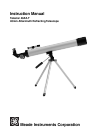
– 6 –
their positions during any 2 or 3 hour observing session, the platform on which the telescope is sitting
(the Earth) rotates once every 24 hours underneath these fixed objects. To keep astronomical objects
centered in the field, simply move the telescope on one or both of its axes (vertical and/or horizontal),
using the altitude control handle (5, Fig. 1) as appropriate. At higher powers, astronomical objects will
seem to move through the field more rapidly.
4. Avoid touching the eyepiece while observing through the telescope. Vibrations resulting from such
contact will cause the image to move. Likewise, avoid observing sites where vibrations may resonate
the tripod. Viewing from the upper floors of a building may also introduce image movement.
5. Allow a few minutes for your eyes to become “dark adapted” prior to attempting any serious
observations. Use a red-filtered flashlight to protect your night vision when reading star maps, or
inspecting components of the telescope.
6. Avoid setting up the telescope inside a room and observing through an open window (or worse yet, a
closed window pane). Images viewed in such a manner may appear blurred or distorted due to
temperature differences between inside and outside air. Also, it is a good idea to allow your telescope
a chance to reach the ambient (surrounding) outside temperature before starting an observing session.
7. We repeat the warning stated at the outset of this manual:
NEVER POINT THE TELESCOPE DIRECTLY AT OR NEAR THE SUN AT ANY TIME!
OBSERVING THE SUN, EVEN FOR THE SMALLEST FRACTION OF A SECOND, WILL RESULT
IN INSTANT AND IRREVERSIBLE EYE DAMAGE, AS WELL AS PHYSICAL DAMAGE TO THE
TELESCOPE ITSELF.
8. Certain atmospheric conditions can distort an observed image. Planets, in particular, viewed while low
on the horizon, often exhibit lack of sharpness—the same object, when observed higher in the sky, will
appear to be much better resolved with far greater contrast. Also, turbulent air in the upper atmosphere
can cause the images to “shimmer” in the eyepiece—reduce power until the image steadies. Keep in
mind that a bright, clearly resolved, but smaller image will show far more interesting detail than a larger,
dimmer, fuzzy image.
9. The 40AZ-T may be used for a lifetime of rewarding astronomical and terrestrial observing, but basic to
your enjoyment of the telescope is a good understanding of the instrument. Read the above instructions
carefully until you understand all of the telescope’s parts and functions. One or two observing sessions
will serve to clarify these points forever in your mind.
10. The number of fascinating objects visible through your 40AZ-T is limited only by your own motivation.
Astronomical software, or a good star atlas (check out your local library, bookstore or the Internet) will
assist you in locating many interesting celestial objects. These objects include:
•
Jupiter and its four major moons, visible around the planet, changing position each night. Also cloud
belts across the surface of Jupiter.
•
Saturn and its famous ring system.
• The Moon: A veritable treasury of craters, mountain ranges and fault lines. The Moon is best observed
during its crescent or half phase when Sunlight strikes the Moon’s surface at an angle. It casts shadows
and adds a sense of depth to the view. No shadows are seen during a full Moon, causing the overly
bright Moon to appear flat and rather uninteresting through the telescope.
•
Deep-Space: Nebulae, galaxies, multiple star systems, star clusters. These objects are best viewed at
a dark site, away from city and other lights.
•
Terrestrial objects: Your telescope may also be used for high resolution land viewing. In this case,
note that the diagonal mirror results in an image which is reversed left-for-right, but which is correctly
oriented up-and-down. Terrestrial observations should almost always be made using a low power
eyepiece (50x or less) for bright, sharp images. Land objects will not normally accept higher powers well
because the telescope is being pointed through the thickest part of the Earth’s atmosphere, unlike
astronomical observations made by pointing the telescope up and through a thinner atmosphere.










